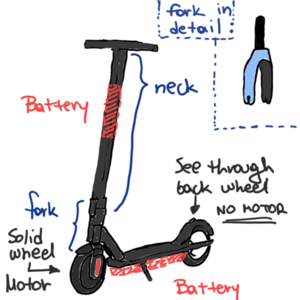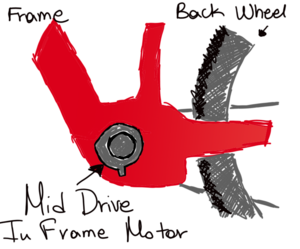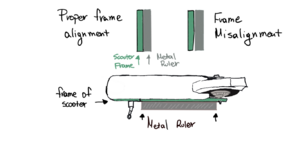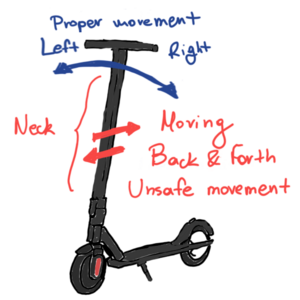Personal e-transport
This page covers e-bikes, e-scooters, hoverboards and similar battery-powered personal transport devices.
Summary
All types of personal e-transport consist of various electrical subsystems in addition to the mechanical frame and drive, each being prone to different faults, and considered in turn.
Safety
- E-bikes and scooters etc all include a fairly powerful rechargeable lithium battery. Physically or electrically abused, this can present a serious fire risk. If possible, avoid charging in the house, and do not leave the charger connected for an extended period.
- Always use the charger that came with your device. If this is impossible, take great care to ensure a replacement charger is fully compatible. Cheap subsitutes may costitute a severe fire risk
- If refurbishing a battery with new cells it's essential that you understand how to correctly charge and balance the cells.
- The motor is likely to be quite powerful and any associated gears could cause serious injury to fingers if it started unexpectedly. Disconnect the battery as the first thing you do and reconnect it as the last.
Basic Battery Faults Diagnosis
Start with the basics by trying to charge your battery with the official charger that came with your electric vehicle. The owner's manual should tell you how your vehicle indicates (usually by means of a LED) whether it is charging and when fully charged. When fully charged, check the battery output voltage with a multimeter by connecting the multimeter to the battery terminals. If the measured voltage is significantly lower than the battery's rated voltage you might need to get a replacement or have it fixed by a professional repair shop.
The BMS (Battery Management System) controls the balanced charging and discharging of individual cells. If you can get physical access to the BMS board, without touching any of the battery's cells or contacts, check the thickness of the wires connecting the BMS board to the individual cells. Often BMS manufacturers will use minimum acceptable guage wires, leading to bad connections or the battery quickly losing efficiency. In such a case a new higher quality BMS may be required, fully capable of handling the current your device requires. DO NOT attempt to fit this unless you can easily gain access to the BMS and are fully competent to replace it. Otherwise, seek the services of a qualified technicien.
Electric Motor Problems
Type of electric motor
Most electric scooters, bicycles and hoverboards use brushless motors. If your vehicle has a brushed DC motor then changing the graphite brushes regurarly to avoid sparks and damage to your motor's commutator should be a part of your maintenance every once in a while.
Identify the electric motor or motors of your vehicle
- In electric scooters the motor is embedded within the wheel, usually leaving no room for air to pass through the it. Identify whether the back or front wheel is the one powered. In certain cases it might be both.
- In hoverboards it's usual for both wheels to have embedded hub motors in their wheels.
- In electric bikes the motor can be either embedded within the frame close to the pedals, or can be found most commonly on the hub of the back wheel.
Grinding sounds from tthe motor
If the motor doesn't spin freely but makes a grinding noise as it turns you might have a bad bearing that needs changing. Generally, you need to dissasemble the wheel to reach the bearing, and then replace it with a new one of the same size, and regrease it. Reassemble the wheel and check that the grinding noise is gone.
If the noise is not constant but speeds up as the motor speeds up, the motor may have an embedded disk brake which you should check. If this is misaliged then it may be the source of your problem.
If the motor shakes or vibrates when powered on
If the motor vibrates or shakes when turned on then perhaps the motor has internal issues such as (in the caseof a brushe motor) worn or sparking brushes.
Alternatively, the power supply may be unable to supply the motor with sufficient current. Reassemble the vehicle completely, and connect the battery. Check whether the battery reading fluctuates at the display during the startup of the motor. If the motor keeps vibrating then it's likely to be either a faulty battery or controller since both are required to function correctly for the motor to reach its maximum speed.
Powering the motor from another power supply
To independantly power a motor intended for an electric vehicle you need a power supply capable of outputting the same the voltage and at least the same current as the vehicle's battery, usually written on the battery itself. Do not attempt this unless you are competent to work with high currents at up to 48V, but instead, seek professional help.
If you are a competent to do so, identify the negative and positive motor terminals and apply a voltage through an appropriate power supply to turn the motor. If the motor does not move, try giving it a spin first by hand. Turning the motor by spinning the wheel helps the motor start, since electric motors can demand three times the normal current during starting. By turning the motor, you avoid demanding such a big starting current from your power supply.
Electronic problems
Dissassemble to access the electronics
After you've identified the electric motor or motors in your vehicle try to find a disassembly video or written tutorial and follow it closely. This is important because the powerful battery could cause damage or a fire if improperly disassembled. In particular, for safety, remove the battery as soon as you can without damaging anything.
Choose a replacement speed controller board
If you looking for a replacement electronic speed controller (ESC) for your electric vehicle in general you need one capable of handling the voltage produced by the battery and its maximum current rating. These figures are usually written on a label on the battery itself or may be in the owners manual. Choosing a speed controller capable of handling more current than your current may result in a faster final motor speed but may deplete the battery faster, requiring more frequent charging and may also shorten the battery life. For lower current speed controller boards the opposite is true, resulting in a lower final motor speed and slower overall vehicle but your battery won't deplete as fast. Make sure if you are replacing the controller boards that they are fitted the same way the originals. They must be firmly bolted to the aluminium frame with thermal paste to aid heat conduction to the frame, otherwise they are likely to overheat and fail.
Checking the electronic circuits
If you know how to use the continuity mode in your multimeter you may be able to identify any potential short circuits, grounding faults or other apparent faults on the controller board or between it and other parts. If the controller boards are covered with silicone for protection and waterproofing, continuity checks on the board itself will not be possible. Carry out a careful visual check of the boards to make sure there is no evidence of water damage, or signs of burnt or improperly soldered components. Keep in mind that in addition to the controller board there will often be other boards to drive the display, the electric motor and other subsystems. An understanding of the symptoms may help you determine which board is at fault and whether it might be replaceable.
The grey paste on the speed controller
Since the speed controller handles a lot of power it can get hot and needs some form of thermal management. Thermal paste, just like that used for computer CPUs, may be applied to one side of the controller boards to improve the thermal contact with the aluminium frame and heat conduction to it to dissipate heat. In e-scooters this is usually the part you stand on. Electric bikes and hoverboards etc will have the same need to dissipate the heat from the speed controller, but with different types of frame they will do it slightly differently.
Moisture problems
Most electric vehicles include moisture detection strips that turn pink in the presence of humidity. If you encounter these strips while opening the vehicle's electronics or battery enclosure and see they have turned pink, then any problems may be due to ingress of moisture. First of all, check circuit boards and connectors for signs of corrosion, cleaning them if necessary with isopropyl alcohol and a stiff brush. Then check the enclosure for cracks or any other damage. You may be able to effect a repair (after thorough cleaning) with 2-part epoxy adhesive. Also, check the integrity of the seal (perhaps a rubber gasket).
Mechanical Problems
Alignment problems
If the electric scooter doesn't run straight when trying to drive straight, or if it just feels unsafe you should check the alignment of the back wheel with the frame. To do that put a metal ruler across the frame with the ruler touching as much of the lower frame chassis and the motor wheel bracket as much as possible. If the metal ruler touches the entire frame and back wheel bracket in a uniform way without gaps then the scooter is correctly aligned. If there are small gaps between the frame or bracket of the wheel and the metal ruler then that may means the fork of the scooter is not straight. This could be the result of a collision or other mechanical damage, and the fork may need replacing. (The fork of the scooter is the mechanical part that holds together the neck of the scooter with the lower chassis (usually containing the battery and wheels).
If there's play in the neck or it feels unsafe
The neck of the scooter (which connects the steering wheel and lower chassis of the vehicle) shouldn't wiggle back and forth or feel unsafe. If it does more than just just turn right and left securely, there may be some issue with the metal chassis of the neck of the scooter or the fork (the fork as defined above).
Broken parts and urgent repairs
Sometimes mechanical parts connecting the frame together such as the fork or neck of an electric scooter might get bent or broken. In such cases, you can get an appropriate replacement from a trusted seller, though that might take some time. Bear in mind that some parts may be interchangeable between different brands.
If you need an urgent repair, it may be worth seeking the assistance of a local metalworking shop, where you might be able to get a replacement part made, or a similar part for another brand of scooter modified to fit.
Such improvised repairs are not recommended for you to do yourself unless you have access to a fully equipped workshop and have the required workshop skills, but are mentioned as they could be an option for a temporary fix.
Remember that any improvised fixes (indeed, any fixes not performed to a high standard) will almost certainly void any warranty you might have. Even more importantly, you could end up with a vehicle that is a danger to yourself and to other people. Always use it with caution, and never on roads, pavements or paths in contravention of the law.



